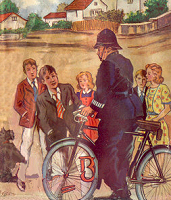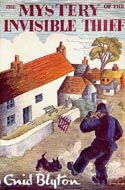
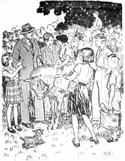
Inspector Jenks' goddaughter Hilary is about to go riding.
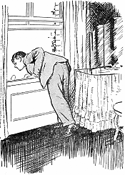
Fatty nips upstairs to see how the thief got in and out.
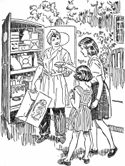
Daisy and Bets try to find out things from the grocery girl.
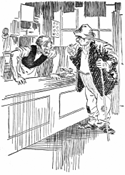
A disguised Fatty questions the cobbler about shoes!
The Mystery of the Invisible Thief
Review by Keith Robinson (January 27, 2005)
The eighth book in the series is a nice whodunit and howdedoit that keeps you guessing all the way through—that is, if you don't already remember the ending! Unfortunately I did from reading these books when I was much younger, but after getting over my disappointment of not having a cracking unknown twist to look forward to, I enjoyed this one a lot. It's pretty clever. The thief of the title breaks into houses and steals a few valuables before vanishing into thin air. No one sees him come or go. It's as if he's invisible! And this thief is so sure of himself that he leaves his big footprints and gloveprints everywhere—together with a curious round indentation with a criss-cross pattern in the dirt. And then there are a couple of other weird clues that just don't seem to fit anywhere...
I can't remember if, when I first read this, I guessed who the culprit was. But I remember slapping my forehead and thinking, "So that's what the strange round criss-cross pattern is!" Then everything fit, and the result was a nice warm feeling that you should always get when you finish a book. Yeah, this is a good one.
Alongside the mystery itself is something new—Mr Goon disguising himself, not once but twice (three times if you count his impromptu disguise when Fatty comes calling at his house). Old Clear-Orf's first disguise completely fools four of the Find-Outers, but naturally Fatty sees right through it from the outset. The second disguise doesn't fool anyone, and there's a really funny moment when each of the kids walks up to Goon and asks for the time or a bit of loose change. Goon tries to maintain his disguise and replies rudely each time, but the kids just say brightly, "Thanks very much," and walk cheerfully away.
The baker boy and his sister are good colorful characters, and there are others that are Blyton's usual style (notably the cooks and maids, who are nearly always portrayed as bubbly and cheerful but none too bright). Inspector Jenks' goddaughter, Hilary, is also quite interesting, although she's not in the story much. And at the start of the book there's another policeman in the village, Mr Tonks, who is covering for Mr Goon while he's away on a police refresher course (hence his disguises later in the book). Tonks is a city man, and can't wait to leave Peterswood to Goon. He thinks Goon is a bit of a turnip-head, and unlike PC Pippin in The Mystery of the Pantomime Cat, Tonks isn't afraid to talk back to him.
There are a couple of occasions when Mr Goon really is a turnip-head. He gets a call from a lady to say there's been another robbery, and when he arrives and knocks on the door, Fatty opens it, grinning broadly. Goon assumes Fatty has set him up, so gets angry and goes home. But it was a real robbery; Larry and Daisy happen to live next door, and of course they (along with Fatty) had popped next door to see what all the fuss was about. So Goon ends up looking like an idiot.
On another occasion he goes to question a cobbler and then the old Colonel about boots—in particular, boots that fit big feet. Both look at him as if he's mad, and it's funny to me how Goon finds it so hard to say something like, "Important police business, sir. I found some footprints of a possible burglar, and I need to examine your boots." Who could argue with that? But he lets himself get intimidated by these people who look at him as if he's gone mad. "My boots? What's all this about boots? Go away and stop wasting my time." Old Clear-Orf really is hopeless around people, isn't he?
As a side note, I think this is the only book so far that doesn't have several missing dialogue quotes here and there. There was one typo I noticed, but I can forgive the typesetters one little mistake. We all make them! But all the previous books have a number of quote marks missing, and I can't help wondering: Is this the fault of the typesetters, or the editor for not proof-reading properly? Normally authors proof-read the final galleys before the book goes to print, but in this case there is no author available! So I wonder if the publisher, Egmont, had their own typesetting done (in which case it's their fault there are gaffs) or if they just inherited the typesetting from a previous publisher and didn't bother checking it through. Oh well.
Overall, after the weakest book so far (The Mystery of the Spiteful Letters) these books are now consistently good. Eight books through, seven more to go.


